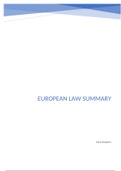Summary
Summary European Law
- Course
- Institution
- Book
Summary of the Book 'European Union Law' by C. Barnard, S. Peers (Oxford University Press, 2017) Specific content of the Summary (divided over the different lectures) Chapter 2 Chapter 3 Chapter 5 Chapter 6: sections 1-5 Chapter 9 Chapter 10: sections: 1, 2, 3.1 (3.1.1-3.1.2-3.1.3- 3.1.4), 3.2 (3....
[Show more]





